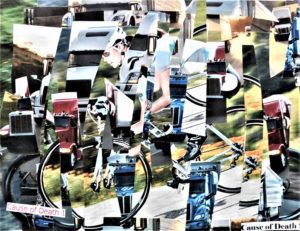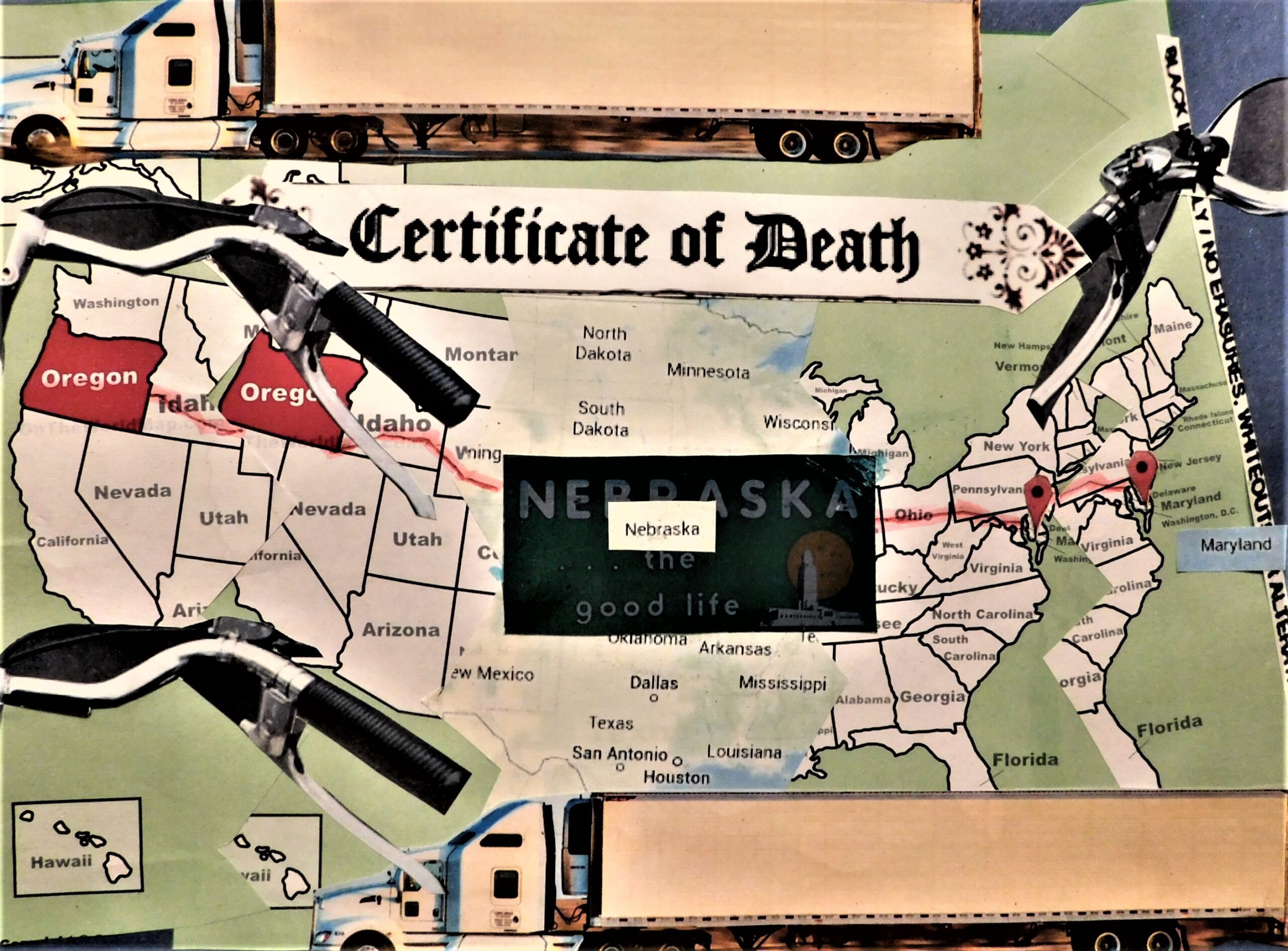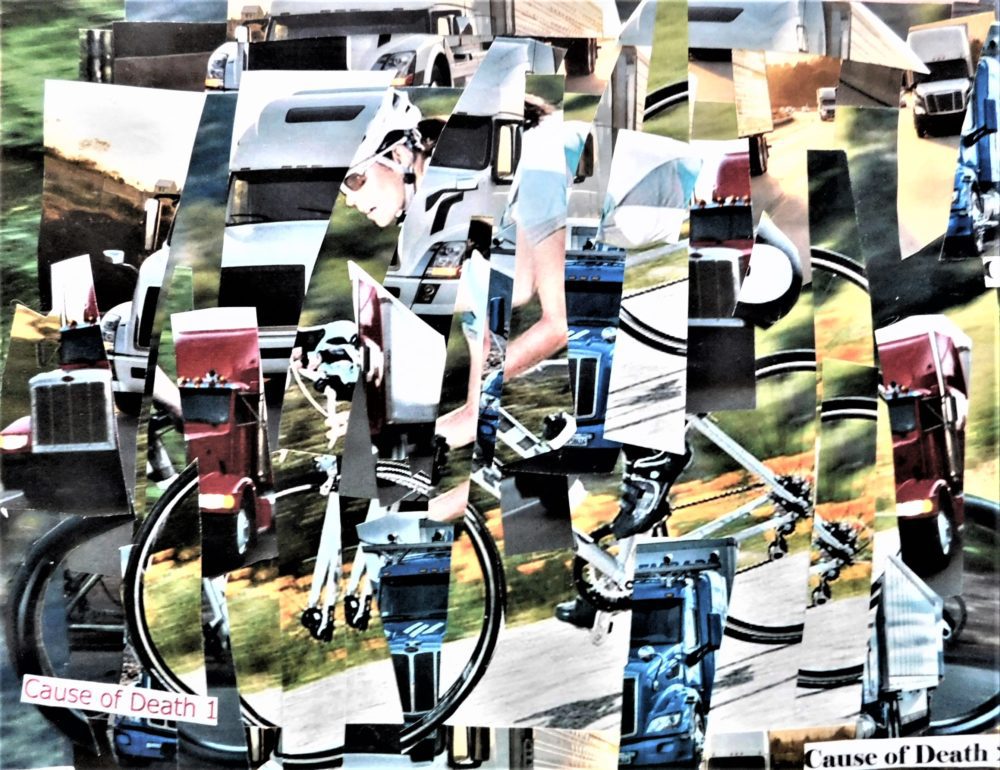
Before I met you, even before I figured out it is possible to be an adrenaline junkie terrified of death, my uncle told me to stay close to the age of ten—that’s where I’m safest. This is true for anyone who lives in the United States if “safety” is defined as “not dying,” as Americans are least likely to die when we are ten years old.
The Social Security Administration and the Center for Disease Control keep tabs on who is dying and when and how they’re doing it. This data is important for relevant public health policy and for profiting off statistical discrimination, among other things. The SSA makes actuarial life tables that display the probability of an individual’s death based on their age during the year of interest, as well as an estimate for their remaining years, in order to help Americans decide when to start collecting social security. The first thing I realized while reading these tables: To be born is risky business. Americans are more likely to die during their first year of life than any other time between their first birthday and their fifties (no factors apart from age considered). Most babies who die do so between the moment they’re born and twenty-eight days later. Once an American survives their first year, their mortality probability decreases dramatically. The probability of their death will decrease each year until they turn ten, then gradually and consistently increase every year from their eleventh birthday until they croak.
Although Americans only become more likely to die as we age, the likelihood of particular causes and manners of our deaths change, sometimes drastically, across our lifespan. According to the Center for Disease Control, in 2015, toddlers were more likely to be murdered than to die of cancer. Elementary-schoolers were more likely to die of cancer than to be murdered. In the most recent years with relative available data, teenagers crashed cars, adults accidentally poisoned themselves (mostly with drugs [mostly opioids]), and retired Americans who survived everything up until this point died of heart disease.
Ten is the safest age in the US if no other factors are taken into account (“safety” still meaning “not dying”). It is safer to have a college degree (alternatively: It is safer to be affluent), to not own a gun, and to be married. A study tracking the longevity of over eight hundred Tour de France cyclists born between 1892 and 1942 from Belgium, France, and Italy concluded that these cyclists’ average lifespans (eighty-one-and-a-half years) were seventeen percent longer than those of the general population born in the same years in the cyclists’ respective countries (seventy-three-and-a-half years).
During the summer of 2017, I rode a bicycle from Maryland to Oregon on a team of twenty-three young adults as part of a fundraiser. You had done the same the previous summer, and I met you when you came with your team to cheer on mine during the first of seventy days we spent hauling ourselves across the country.
There are mountains of evidence suggesting cycling increases longevity, but sometimes, I can’t help but hypothesize: It’s safer to never ride a bike at all.
There are five legal definitions for manners of death in the United States: natural, accident, homicide, suicide, and undetermined. Causes of death are specific injuries and illnesses. Cancer is the cause of a natural death. Drowning is the cause of an accidental death, unless the drowning happened on purpose, then drowning is the cause of a homicide or suicide. While “old age” is neither a manner nor cause of death, it often causes causes of death.
When I was ten, the fact of “safety,” in my uncle’s narrow definition, comforted me. Had we complicated our definition of “safety” to encompass the danger of childhood sexual abuse, I would have been in the un-safest category for age (seven to thirteen) and sex (female). But staying safe was staying alive, and I felt safe in the blur of bike rides to friends of friends’ houses, even when it was possible for danger to find me within that blur.
Children who are abused often do not die, but there can be other consequences. I started double-checking the locks on every door and first-floor window. My sock drawer filled up with stolen toys, gum, collectible coins, and the occasional gemstone. Five birthdays later, I aged out of the highest risk category for sexual abuse, yet someone new put their hands on me, taught me I can’t always count on the statistics that made me feel safe enough.
If an injury worsens an illness until it becomes fatal, or vice versa, which is the cause of death? Death certificates have space for multiple causes of death, but they must be listed as though there was a domino effect. There is space for one “immediate” cause (the last domino) and one “underlying” cause (the first domino) of death, and a couple more in between. If the immediate cause of death is ambiguous, if every awful thing happened at once, the forensic pathologist preparing the death certificate gets to exercise her opinion on which cause of death was deadliest.
When a person is sexually assaulted, their risk doesn’t diminish or stay the same as it had been prior to the assault. The risk swells. It is still swollen.
Is feeling safe ever reasonable?
A cyclist named Ken Kifer wrote a defense of the safety of cycling as a sport, claiming the general public’s perception of the danger of cycling is highly inflated, and this ultimately hurts us: People are afraid to ride bikes, thus, they miss out on health benefits. He cited a study that concluded .26 cyclists die for every one million exposure hours (meaning every one million hours of collective cycling). This would have been a comforting statistic before I realized these figures were from 1986, from before you went out biking and, consequentially, died.
We spent a day together, but I believe we are linked by sharing a bike route. Seventy days of your life mirrored seventy days of mine. Along the route with our respective fundraising teams, we slept in the same basements, sprinted to finish the same century rides before dark, each felt the surprise of our thighs filling up jeans by the time we got to South Dakota. On Cape Meares, I spent hours combing the beach for sand dollars and you learned what happens when someone throws their bike in the ocean.
A few times each year, my uncle calls to ask if I know about his latest anxiety, like how many Americans die every day from opioid overdoses (just over one hundred and thirty as of 2017; this number has increased at alarming rates since 1999) and how likely I am to be roofied (the data is scarce, but I should stay vigilant and watch bartenders make my drinks). If I am still alive and biking on my forty-sixth birthday and if the figures stay the same (they probably won’t), he might give me a ring to let me know I am the average age of cyclists killed and need to wear a reflective band and stay on guard in intersections and be okay and make it to the end of my projected lifespan or he doesn’t know what he’ll do. The country we grew up in and biked across pegged your life expectancy at seventy-nine. You were twenty-one years too young to die on a bicycle and fifty-four years too young to die.
It was just before dinnertime, somewhere on the route in Nebraska, when I found out you were killed. A month before, you were hanging out a car window, your hand in the belly of a bird puppet, moving your fingers to open his beak and make him shout, “GIT IT GIT IT GIT IT GIT IT GIT IIIIIIIT!” as my team and I struggled to pedal up a mountain. Eighty miles past Baltimore’s Inner Harbor, just a few minutes after that mountain kicked my ass, you were dancing in a parking lot with your team and Petey the bird puppet and you were all full of life and we caught on, the aching in our thighs vanished or numbed or didn’t matter, and everyone was dancing, radio blasting out of the car with every door wide open. How could you be gone? How could all that life in you get snuffed out in one go? Why was it you when it could have just as easily been one of us?
Many of us in the cycling community don’t spend a lot of time worrying about our vulnerability until we have a close call or hear about an accident. There are other things that make me feel vulnerable: when drivers roll coal on me; when I’m in a car watching other people on their bikes; and when I read about people like Ken Kifer, who knew that .26 cyclists used to die for every one million exposure hours, who couldn’t have known someday he, too, would be killed on his bicycle.
Maybe you were like me and spent the first few weeks of your cross-country trek twisting your neck back and forth in panic. You probably understood this mental state as fight-or-flight; when the amygdala perceives a threat, our adrenal glands pump out epinephrine (aka adrenaline); our heartbeat quickens to send blood where blood is needed; and our lungs make space for more oxygen to feed the brain, sharpening our vision, hearing, and smelling. Ideally, we become anxious superhero versions of ourselves.
We are designed to recognize danger and panic, to remove ourselves from dangerous circumstances with our new superpowers, and to remember the threat so we can take precautions to avoid recurrence. By this logic, humans should never be adrenaline junkies. But when a thrill-seeker overpowers their amygdala’s freakout, fight-or-flight isn’t unpleasant. It is ideal. There are several hypotheses for why this is, and I can anecdotally attest to the truth of this one: When we’re focused enough, we can’t worry about our carbohydrate intake and fucking up elevator pitches and forgiving the people who’ve made some things scarier than bungee jumping and rock climbing and biking on shoulderless highways. All we have to do is survive, and we’re doing it fabulously. We feel invincible. We feel we are operating in our top gear.
I have another hypothesis I’d like to talk about over coffee with your ghost. After a few weeks of exposure to semi-trucks brushing past our shoulders, our fight-or-flight response should have weakened and we should have felt our gear shift down, right? Instead, did you shift up and discover an even higher gear, too? Part of what gets us giddy off of adrenaline is choosing to take the (often literal, in our case) jump, the declaration: We aren’t going to reconcile our fear of mortality probability by chickening out. After making the choice to bike shoulder to shoulder with semi trucks again and again, we really started to believe, against all our neurobiological programming, this breath matters more than maximizing the promise of future breaths. The highest gear is how we forgot about mortality for a minute, lifted our hands from handlebars and felt the wind fill up our palms; how the wildflowers dotted the Tetons; how we were once in Baltimore and thousands of miles sprawled to the west of us and we pedaled and pedaled and pedaled until all of it was east.
***
Rumpus original art by David Dodd Lee.







